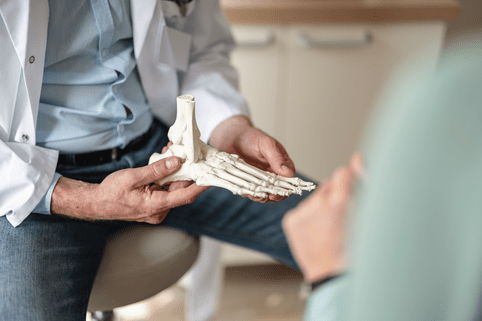Riverside Orthopedic Foot and Ankle Specialists
At Riverside, we offer advanced imaging, non-operative foot and ankle treatment options and minimally invasive surgical treatments for all types of foot and ankle conditions. Whether you’re recovering from an injury or managing a chronic disorder, we’re here to help you return to the activities you love.

“In Orthopedics, our goal is to relieve pain and get patients back to a high level of activity, so when they come to see me and then they’re able to get back to doing what they love to do and are improved, I can’t think of anything more rewarding.” – Dr. Jeffrey A. Levy, D.O.
Understanding Foot and Ankle Pain and Some Common Treatment Options
Whether you're dealing with chronic foot or ankle pain, a recent injury or are simply exploring treatment options, you're not alone and you've come to the right place. Our expert team of foot and ankle specialists at Riverside is here to help you better understand common foot and ankle conditions and the full range of non-surgical and surgical treatment options available.
Here are ten common symptoms related to the foot and ankle. Foot and ankle pain can be caused by a variety of factors, ranging from injuries to underlying medical conditions. Understanding the causes of foot and ankle pain is crucial to effectively diagnose and treat the issue. It is important to note that any persistent or severe symptoms should be evaluated by a health care professional for accurate diagnosis and treatment.
- Pain: Foot and ankle pain can occur due to various reasons such as sprains, fractures, tendonitis or arthritis. The intensity and location of the pain can vary depending on the underlying cause.
- Swelling: Swelling in the foot or ankle area may be a result of an injury, inflammation or underlying medical conditions like edema or lymphedema.
- Stiffness: Difficulty in moving the foot or ankle joint freely can indicate joint stiffness caused by conditions like arthritis or overuse injuries.
- Numbness or tingling: Sensations of numbness or tingling in the foot and ankle region may be indicative of nerve compression, such as in cases of peripheral neuropathy or nerve entrapment syndromes.
- Instability: Feeling unsteady while walking or standing can be a sign of weakened ligaments or unstable joints in the foot and ankle.
- Limited range of motion: Difficulty moving the foot up/downwards (dorsiflexion/plantarflexion) or sideways (inversion/eversion) could suggest joint restrictions caused by injuries or degenerative conditions like osteoarthritis.
- Deformities: Foot deformities like bunions, hammertoes, flat feet (pes planus), high arches (pes cavus), clubfoot (congenital talipes equinovarus), etc., can cause discomfort and affect mobility.
- Weakness: Muscle weakness in the foot and ankle can result from nerve damage, neuromuscular disorders or prolonged immobilization.
- Redness and warmth: Inflammation due to infections, gout, cellulitis or other inflammatory conditions may lead to redness and warmth around the affected area.
- Popping or snapping sensation: A popping or snapping sensation or sound can signal a possible tendon issue.
Foot and ankle pain can be caused by a variety of factors, ranging from injuries to underlying medical conditions. Understanding the causes of foot and ankle pain is crucial to effectively diagnose and treat the issues. Injuries such as sprains, fractures or strains are common culprits of foot and ankle pain.
- Arthritis in the Foot and Ankle
Foot and ankle arthritis causes inflammation and degeneration of the joints, most often in the ankle, midfoot or big toe.
Common symptoms include:
• Joint pain and stiffness
• Swelling around the joint
• Limited range of motion
Untreated arthritis can worsen over time, leading to joint deformity. Treatment options include anti-inflammatory medications, custom orthotics, physical therapy and when necessary, joint fusion or replacement.
- Flat Feet (Fallen Arches)
Flat feet, or pes planus, occur when the foot's arch collapses and the entire sole touches the ground. This can be present from birth or develop in adulthood due to posterior tibial tendon dysfunction.
Complications may include:
• Leg fatigue
• Ankle instability
• Knee or hip pain
- Bunions (Hallux Valgus)
A bunion is a bony bump that develops at the base of the big toe, often caused by genetics, foot structure or improper footwear.
Signs to watch for:
• Swelling, redness or tenderness
• Pain when walking
• Difficulty finding comfortable shoes
- Hammer Toe Deformity
Hammer toe, or hammertoe, causes one or more toes – usually the second, third or fourth toe – to bend downward at the middle joint. This can result from muscle imbalance, tight shoes or genetic predisposition.
Common symptoms:
• Toe pain and stiffness
• Corns or calluses on the toe
• Difficulty wearing shoes
Treatment depends on severity: splinting, orthotics or surgical correction for advanced cases.
- Metatarsalgia (Ball of Foot Pain)
Metatarsalgia refers to inflammation in the ball of the foot, often under the second and third toes. It’s common in runners, people with high arches or those who wear ill-fitting shoes.
Symptoms:
• Sharp or burning pain when walking
• Tingling or numbness in the toes
• Increased discomfort during physical activity
Treatment may include rest, ice, footwear modification and shock-absorbing insoles.
- Chronic Ankle Instability
Chronic ankle instability often stems from repeated ankle sprains that damage the ligaments. It leads to the ankle frequently “giving out,” especially on uneven surfaces.
Signs include:
• Ongoing ankle weakness
• Swelling after activity
• Balance or stability issues
Treatment may involve physical therapy, balance training and in persistent cases, ligament reconstruction.
- Osteochondral Lesions (Cartilage Damage)
These are injuries to the cartilage and bone beneath the cartilage in the ankle joint, typically from trauma like a severe ankle sprain.
Warning signs:
• Deep ankle pain with activity
• Catching, clicking or locking
• Swelling
Advanced imaging (like MRI) is usually needed for diagnosis. Treatment options range from non-surgical care to arthroscopy or cartilage grafting.
- Foot and Ankle Fractures
Fractures may result from trauma (e.g., a fall or direct impact) or repetitive stress. Types include complete fractures and stress fractures.
Symptoms vary:
• Sudden sharp pain, swelling and bruising (complete fractures)
• Dull, worsening pain with activity (stress fractures)
Treatment includes immobilization, activity modification or surgical repair depending on the severity and location.
- Achilles Tendon Injuries
The Achilles tendon connects your calf muscles to your heel bone and is prone to inflammation (tendinitis) or rupture from overuse or sudden movement.
Symptoms:
• Heel pain or stiffness
• Swelling and tenderness
• Difficulty pushing off or rising on toes
Most cases improve with rest, ice and physical therapy, but tears may require surgical repair.
- Plantar Fasciitis (Heel Pain)
Plantar fasciitis is one of the most frequent causes of heel pain. It involves irritation of the plantar fascia, the band of tissue supporting your arch.
Typical symptoms:
• Stabbing heel pain first thing in the morning
• Discomfort after long periods of standing or walking
• Tenderness at the bottom of the heel
Treatment options include stretching exercises, night splints, orthotics, and, in some cases, corticosteroid injections or shockwave therapy.
It is important to note that this list is not exhaustive, and there are other foot and ankle conditions that individuals may experience. If you are experiencing any persistent foot or ankle pain or have concerns about your foot and ankle health, don’t wait to consult with a foot and ankle specialist for an accurate diagnosis and appropriate treatment.
Within foot and ankle orthopedic care, many conditions can be effectively managed without surgery. Non-surgical treatments aim to reduce pain, restore function and improve mobility, enabling patients to return to their normal activities. These options are often recommended as first-line treatments before surgical intervention is considered.
- Self-Care and the R.I.C.E. Protocol: At-home self-care often begins with the R.I.C.E. method (Rest, Ice, Compression, and Elevation), especially for acute injuries like sprains or strains. Avoiding weight-bearing activities and applying ice intermittently can significantly reduce inflammation and swelling.
- Orthotics and Footwear Modifications: Custom-made or over-the-counter orthotic inserts can redistribute pressure, cushion sensitive areas and support foot mechanics. They are commonly used for conditions like plantar fasciitis, flat feet and bunions. Proper footwear that is well-fitted, with cushioning and arch support, also plays a crucial role in preventing and managing symptoms.
- Medications for Pain and Inflammation: Nonsteroidal anti-inflammatory drugs (NSAIDs) such as ibuprofen or naproxen are frequently used to manage pain and inflammation associated with arthritis, tendonitis or acute injuries.
- Bracing, Taping, and Mobility Aids: Ankle braces, compression wraps or walking boots may be used to stabilize joints, protect injured tissue and allow healing. In more severe cases a cane or crutches may help offload pressure during recovery.
- Physical Therapy: A structured physical therapy program can restore strength, flexibility and range of motion after injury or flare-ups of chronic conditions like Achilles tendinopathy or ankle instability. Modalities such as ultrasound, manual therapy, and balance training may also be incorporated to prevent recurrence.
- Injections for Symptom Relief: Corticosteroid injections into joints, tendons or bursae can reduce inflammation and pain in conditions like arthritis, plantar fasciitis or tarsal tunnel syndrome. In some cases, platelet-rich plasma (PRP) therapy may be offered to promote healing using a patient’s own growth factors, particularly for tendon injuries.
It is important for individuals experiencing foot and ankle issues to consult with a qualified healthcare professional who specializes in orthopedics or foot and ankle surgery. They will assess each case individually and recommend an appropriate treatment plan tailored to meet specific needs for optimal recovery outcomes.
When surgery is the best option, there are various options available to address different foot and ankle conditions and injuries. It is important to consult with a health care professional specializing in orthopedics for an accurate diagnosis and personalized treatment plan based on individual needs and specific foot and ankle conditions. Here is a list of some of the most common surgical treatments for foot and ankle-related issues:
- Bunion Correction
Bunions are painful bony bumps that form at the base of the big toe, often causing inflammation, limited mobility and discomfort with shoes. Bunion surgery helps restore proper joint alignment, addresses the structural issue and reduces pressure on the affected area. The outpatient surgery is quick – typically done in less than an hour – and recovery can take just in a few months, in most cases.
Depending on the severity, your surgeon may:
• Reshape or remove part of the bone
• Realign tendons and ligaments
• Use screws or plates to hold the new alignment
At Riverside, Dr. Levy is uniquely qualified to perform a minimally invasive form of bunion correction that has smaller incisions, faster recovery times and often results in less pain or discomfort for the patient.
- Hammer Toe Correction
Hammer toe affects the second, third or fourth toes, causing a permanent bend at the middle joint. If left untreated, it can lead to stiffness, pain and calluses.
Surgical options depend on the flexibility of the toe:
• Minimally invasive release for flexible deformities
• Tendon transfer or joint fusion for rigid toes
• Use of pins or wires to stabilize the bones as they heal
Minimally invasive techniques often lead to faster recovery and less pain.
- Total Ankle Replacement
Also known as ankle arthroplasty, this surgery replaces a damaged ankle joint with a prosthetic implant, preserving movement while reducing pain caused by arthritis or trauma.
Modern ankle replacements have improved dramatically in recent years, and studies show patients often experience long-term pain relief and increased mobility when paired with proper rehab and footwear.
- Flatfoot Reconstruction
Flatfoot (or fallen arches) can lead to instability, ankle pain and arthritis over time. Flatfoot reconstruction is a surgical procedure designed to rebuild the arch of the foot and improve overall alignment and function.
This complex surgery may involve:
• Cutting and reshaping bones
• Transferring tendons
• Lengthening soft tissue
• Fusing joints to maintain alignment
Recovery can take several months but can significantly improve function and relieve chronic pain.
- Big Toe Arthritis (Hallux Rigidus) Correction
Hallux rigidus refers to arthritis in the big toe joint, often resulting in stiffness and pain during walking.
Surgical options include:
• Cheilectomy – Removing bone spurs and reshaping the joint
• Fusion (arthrodesis) – Fusing bones to eliminate pain
• Joint replacement – In select cases, to preserve motion
Research shows cheilectomy is highly effective in early-stage arthritis, while fusion remains the gold standard for advanced disease.
- Ankle Arthroscopy
Ankle arthroscopy is a minimally invasive diagnostic and treatment option for conditions like bone spurs, ligament injuries and loose cartilage.
A small camera and surgical tools are inserted through small incisions to:
• Clean out debris
• Remove inflamed tissue
• Repair minor damage
- Cartilage Restoration
Cartilage damage in the ankle or foot can make each step painful.
Several surgical techniques promote healing and regeneration:
• Debridement – Trimming damaged cartilage
• Microfracture – Creating small holes in bone to stimulate new cartilage growth
• Grafting – Transplanting healthy cartilage from another site
Current research shows that early intervention offers the best outcomes, especially when combined with physical therapy and offloading.
- Midfoot Fusion for Arthritis
Midfoot arthritis can result from trauma, overuse or aging and causes pain during standing or walking.
Midfoot fusion surgery:
• Removes damaged cartilage
• Realigns bones in the midfoot
• Stabilizes joints with metal plates or screws
This procedure permanently stiffens the arthritic joints to eliminate pain and increase stability.
- Achilles Tendon Repair
The Achilles tendon, known for being the body’s strongest tendon, is prone to strains and ruptures, particularly among physically active adults.
Depending on the injury, treatment may include:
• Traditional open repair
• Minimally invasive techniques
• Grafting or augmentation for chronic injuries
Surgical repair has a high success rate, particularly when followed by guided rehabilitation to restore strength and flexibility.
- Foot and Ankle Fracture Repair
Complex fractures of the foot or ankle may require surgical intervention to restore alignment and function.
Surgery may involve:
• Realigning broken bones
• Securing them with screws, plates or rods
• Repairing associated soft tissue injuries
Recovery varies based on fracture severity, but most patients regain function with proper immobilization and physical therapy.
The expert foot and ankle surgeons at Riverside use the latest surgical techniques to relieve pain and improve function. If you're experiencing discomfort, weakness or limited mobility in your foot or ankle, don’t wait to seek care. With the right treatment in the right hands, you can return to the activities you enjoy.
Minimally Invasive Bunion Surgery Explained
Step inside the operating room and go behind the scenes of a real minimally invasive bunion surgery with Dr. Jeff Levy, a fellowship-trained, board-certified Riverside orthopedic foot and ankle surgeon. Dr. Levy walks you through the step-by-step surgical process, explains why minimally invasive techniques are revolutionizing bunion treatment, and explains what patients can expect before, during and after surgery. To learn more about Dr. Levy or to schedule your appointment with a Riverside orthopedic specialist visit riversideonline.com/levy or call 757-534-9988.

Foot and Ankle Resource Library
Our expert foot and ankle team is here to support you every step of the way, from diagnosis to recovery. Whether you're preparing for surgery or managing a chronic condition, we've compiled trusted resources to help you feel informed and confident in your care. Visit our Foot & Ankle Resource Library to explore common FAQs, pre- and post-op instructions and downloadable guides from foot and ankle surgeon, Dr. Levy.
Visit our Foot & Ankle Resource LibraryMeet Your Riverside Orthopedic & Sports Medicine Foot & Ankle Team
Meet the Rest of the Orthopedic Team
Providing efficient and effective care for any specialized orthopedic need.
Resource Promo
Type
Video
Meet Dr Jeffrey A Levy DO Orthopedic Surgeon
Dr. Levy specializes in foot and ankle conditions such as bunions, flat and cavus foot, joint instability and plantar fasciitis. He offers innovative minimally invasive surgical procedures for bunions, lesser toe deformities and Achilles tendon repair.
Pay Your Bill Easily Online
You can pay your hospital, doctor's office, diagnostic, senior living and emergency room bill all online. Learn more about Riverside Bill Pay and conveniently pay your bill online.





